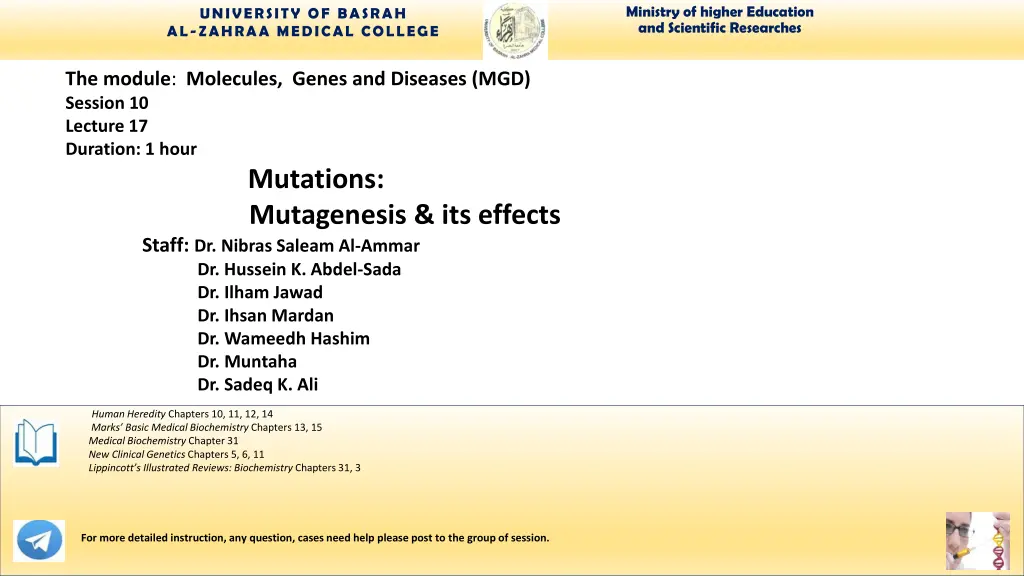
Understanding Mutations in Genetics: Effects, Types, and Mechanisms
Explore the complexities of genetic mutations in the context of human heredity, covering topics such as mutagenesis, different mutation types, and their phenotypic effects. Dive into the relationship between changes in nucleotide sequences and amino acids, as well as the processes of DNA repair and mutational outcomes. Enhance your knowledge of point mutations, silent mutations, missense mutations, and more in this comprehensive lecture session.
Download Presentation

Please find below an Image/Link to download the presentation.
The content on the website is provided AS IS for your information and personal use only. It may not be sold, licensed, or shared on other websites without obtaining consent from the author. If you encounter any issues during the download, it is possible that the publisher has removed the file from their server.
You are allowed to download the files provided on this website for personal or commercial use, subject to the condition that they are used lawfully. All files are the property of their respective owners.
The content on the website is provided AS IS for your information and personal use only. It may not be sold, licensed, or shared on other websites without obtaining consent from the author.
E N D
Presentation Transcript
Ministry of higher Education and Scientific Researches UNIVERSITY OF BASRAH AL-ZAHRAA MEDICAL COLLEGE The module: Molecules, Genes and Diseases (MGD) Session 10 Lecture 17 Duration: 1 hour Mutations: Mutagenesis & its effects Staff: Dr. Nibras Saleam Al-Ammar Dr. Hussein K. Abdel-Sada Dr. Ilham Jawad Dr. Ihsan Mardan Dr. Wameedh Hashim Dr. Muntaha Dr. Sadeq K. Ali Human Heredity Chapters 10, 11, 12, 14 Marks Basic Medical Biochemistry Chapters 13, 15 Medical Biochemistry Chapter 31 New Clinical Genetics Chapters 5, 6, 11 Lippincott s Illustrated Reviews: Biochemistry Chapters 31, 3 For more detailed instruction, any question, cases need help please post to the group of session.
Intended learning outcomes of Lecture 8 At the end of this lecture you should be able to: Explain the relationship between changes in nucleotide and amino acid sequences. (LO.1) Describe the different types of mutational changes, e.g. point mutation, insertion, deletion. (LO.2) Predict and explain the effect that different mutations may have, e.g. silent mutation, missense mutation, nonsense mutation, frameshift mutation.(LO .3) Describe how spontaneous and induced mutations may occur. (LO.4) Describe the process and the role of DNA repair. (LO.5)
(LO.1) This lecture covers the phenotypic effects of mutations and the mechanisms of mutagenesis. The session demonstrates how the position of a single base change in a nucleotide sequence can determine whether there is no phenotypic effect, a relatively minor effect such as a single amino acid change or a drastic effect such as chain termination.
(LO.2) What is a mutation? Mutations are changes in the genetic code and can be classified in many ways; all mutations can be grouped under one of the following: 1-base substitution: change of a single nucleotide to one of the 2-deletion: removal of sequences 3-insertion: addition of sequences 4-rearrangement: rearrangement of sequences
(LO .3) Point mutations are base substitutions and can be either a transition (purine to purine OR pyrimidine to pyrimidine) or a transversion (purine to pyrimidine OR pyrimidine to purine). Point mutations in the coding region of a protein can be a: silent mutation: a mutation that does not alter the amino acid specified missense mutation: a mutation that replaces one amino acid with another nonsense mutation: a mutation that changes the amino acid specified to a stop codon
(LO .3) Point mutations in non-coding regions or outside genes can of course also be detrimental as they can change protein binding sites, promoter sequences, splice sites etc.
(LO.4) Many mutations are spontaneous; mutations can also be induced (by mutagens). Mutations are either somatic or germline. Mutations are not good or bad per se, just different. Mutations are a source of genetic variation. A mutation causes a mutant phenotype, which is a phenotype that differs from the common or wild type phenotype in the population. A mutation in a gene causes a mutant allele, which is an allele that differs from the common allele in the population (the wild type allele).
(LO.4) addition or subtraction of nucleotides other than multiples of 3 : frame shift mutation addition or subtraction of 3 nucleotides (or multiples of 3): no change in reading frame (however, there will be a change in the amino acid code) To illustrate this remember The Fat Cat (see below).
(LO.4) Normal situation, the code makes sense: THE FAT CAT ATE THE WEE RAT 1 bp insertion causes a frame shift, the code is broken: THE XFA TCA TAT ETH EWE ERA T 1 bp deletion causes a frame shift, the code is broken: THE ATC ATA TET HEW EER AT
(LO.4) 3 bp insertion causes no frame shift, the code is changed but not broken: THE BIG FAT CAT ATE THE WEE RAT 3 bp deletion causes NO frame shift, the code is changed but not broken: THE CAT ATE THE WEE RAT or TFA CAT ATE THE WEE RAT
DNA repair The cell has several highly conserved mechanisms in place to check and repair the genetic code. Mutations happen very frequently but are being recognized and repaired very frequently too. For example, in mismatch repair an erroneously inserted nucleotide (e.g. a G-T base pairing) is recognized and replaced with the correct nucleotide. In excision repair small single-stranded stretches of damaged DNA (up to 30 nucleotides; nucleotide excision repair) or a single nucleotide or few damaged nucleotides (1-5 nucleotides; base excision repair) can be excised, and the resulting gap can be filled by DNA polymerase. Failure of DNA repair can have serious consequences to the cell, and can cause disease.
In a healthy cell there is a fine balance between DNA damage and DNA repair.
